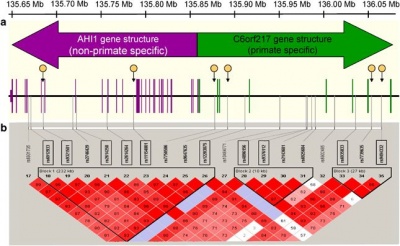Difference between revisions of "LINC00271"
(→Characteristics) |
|||
| Line 13: | Line 13: | ||
===Characteristics=== | ===Characteristics=== | ||
| − | ''C6orf217'' is a primate specific gene located on chromosome 6q23 adjacent to ''AHI1'' gene (Abelson Helper Integration Site 1) <ref name="ref2" />.The two genes appear in opposite orientations and their regulatory upstream regions overlap, which might affect their expression. It consists of 10 exons and has several alternatively splice isoforms but does not seem to encode a functional protein. <ref name="ref1" />. | + | [[File:LINC00271.jpg|right|thumb|400px|'''Genomic location of ''C6orf217'' and orientation with respect to adjacent ''AHI1'' gene. (a) The purple and green arrows indicate AHI1 and C6orf217 orientation, respectively. Gene structure of ''AHI1'' and ''C6orf217'' are depicted in purple and green vertical lines respectively, indicating exon positions. Yellow circles and their connecting arrows point to the location of significant SNPs (after Bonferroni correction). Grey lines indicate the positions of all SNPs genotyped in this genomic region.(b) Haploview representation of SNPs and their LD (linkage disequilibrium) structure.'''<ref name="ref1" />]] |
| + | |||
| + | ''C6orf217'' is a primate specific gene located on chromosome 6q23 adjacent to ''AHI1'' gene (Abelson Helper Integration Site 1) <ref name="ref2" />.The two genes appear in opposite orientations and their regulatory upstream regions overlap, which might affect their expression. It consists of 10 exons and has several alternatively splice isoforms but does not seem to encode a functional protein. <ref name="ref1" />. | ||
===Function=== | ===Function=== | ||
Revision as of 07:46, 14 November 2018
LINC00271, Long Intergenic Non-Protein Coding RNA 271, identified as a candidate gene in schizophrenia and also has suppressive role in many cancer types.
Contents
Annotation
Name
LINC00271
Alias
C6orf217; NCRNA00271 (NCBI:100131814)
Chromosome 6 Open Reading Frame 217 (HGNC:32526)
Non-Protein Coding RNA 271 (HGNC:32526)
Characteristics

C6orf217 is a primate specific gene located on chromosome 6q23 adjacent to AHI1 gene (Abelson Helper Integration Site 1) [2].The two genes appear in opposite orientations and their regulatory upstream regions overlap, which might affect their expression. It consists of 10 exons and has several alternatively splice isoforms but does not seem to encode a functional protein. [1].
Function
C6orf217 encodes a small protein with no known motif and may well function as a regulatory gene either at its mRNA or protein level [1]. In silico studies show that it may function as a regulatory RNA gene, and may be a regulator of an adjacent AHI1 gene or of other genes. Its Suppressive role is observed in many common cancer types including BRCA, LUAD, KIRP and HNSCC [2].
Expression
C6orf217 is expressed in brain, eye, kidney, testis, tongue, pancreas and lung during development as well as in the adult [1]. In a combined group of schizophrenia and bipolar disorder patients, there was increased expression of C6orf217 [2]. Also its expression was significantly downregulated in PTC (papillary thyroid cancer) compared with the level in the adjacent normal tissues [3].
| Experiment | Forward primer | Reverse primer |
|---|---|---|
| qRT-PCR | 5'-GCTATTGGTGGGAGGCTTCAG- 3' | 5'-TGGGCTGGACTTAATGACTTGC- 3'[3] |
Disease
- bipolar disorder [2]
- breast cancer [4]
- head and neck cancers [4]
- papillary thyroid cancer [3]
- schizophrenia, SNPs within this gene is associated with susceptibility to schizophrenia [1]
- type 2 diabetes [4]
- virus infections [4]
Labs Working
- Department of Molecular Genetics, Weizmann Institute of Science, Rehovot, Israel
- Department of Molecular Genetics, Weizmann Institute of Science, Rehovot, Israel
- Department of Psychology, Hebrew University and Sara Herzog Memorial Hospital, Jerusalem, Israel
- Regional Mental Health Center, Taibe, Israel
- Dr Kemal Hospital, Bethlehem, Palestinian Authority, Palestine
- Department of Psychiatry, University of Bonn, Germany
- Department of Biology, University of Milan, Milan, Italy
- Dépt de Génétique Médicale, CHUV-UNIL, Lausanne, Switzerland
- Biological Psychiatry Laboratory, Department of Psychiatry, Hadassah-Hebrew University Medical Center, Jerusalem 91120, Israel
- Psychiatry Research Unit, Faculty of Health Sciences, Ben Gurion University of the Negev and Mental Health Center, Beer Sheva, Israel
- Department of Molecular Genetics, Weizmann Institute of Science, Rehovot, Israel
- Department of Head and Neck Surgery, Fudan University Shanghai
- Cancer Center, Shanghai, People’s Republic of China
- Department of Oncology, Shanghai Medical College, Fudan University, Shanghai, People’s Republic of China
- Institute of Biomedical Science, Shanghai Medical College, Fudan University, Shanghai, People’s Republic of China
- Department of Biological Sciences, Charles E. Schmidt College of Science, Florida Atlantic University, USA
References
- ↑ 1.0 1.1 1.2 1.3 1.4 Amann-Zalcenstein D, Avidan N, Kanyas K, Ebstein RP, Kohn Y, Hamdan A et al. AHI1, a pivotal neurodevelopmental gene, and C6orf217 are associated with susceptibility to schizophrenia[J]. European journal of human genetics . 2006,14:1111-1119.
- ↑ 2.0 2.1 2.2 2.3 Slonimsky A, Levy I, Kohn Y, Rigbi A, Ben-Asher E, Lancet D et al. Lymphoblast and brain expression of AHI1 and the novel primate-specific gene, C6orf217, in schizophrenia and bipolar disorder[J]. Schizophrenia Research. 2010, 120(1):159-166.
- ↑ 3.0 3.1 3.2 Ma B, Liao T, Wen D, Dong C, Zhou L, Yang S et al. Long intergenic non-coding RNA 271 is predictive of a poorer prognosis of papillary thyroid cancer[J]. Scientific Reports. 2016, 6:36973.
- ↑ 4.0 4.1 4.2 4.3 Delgado A P, Brandao P, Narayanan R. Diabetes associated genes from the dark matter of the human proteome[J]. MOJ proteomics & bioinform, 2014, 1(4): 00020.